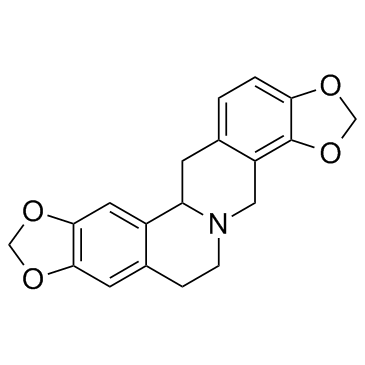Tetrahydrocoptisine ((RS)-Stylopine) (Synonyms: NSC 110382, NSC 404529, (R,S±)-Stylopine) |
| Catalog No.GC33877 |
Tetrahydrocoptisine ((RS)-Stylopine) (Tetrahydrocoptisine) is an alkaloid compound originally isolated from Corydalis tubers that exhibits anti-inflammatory and anti-parasitic activities.
Products are for research use only. Not for human use. We do not sell to patients.

Cas No.: 4312-32-7
Sample solution is provided at 25 µL, 10mM.
Tetrahydrocoptisine is an alkaloid compound originally isolated from Corydalis tubers that exhibits anti-inflammatory and anti-parasitic activities.IC50 value:Target:in vitro: THC significantly inhibited LPS-induced TNF-α, interleukin-6(IL-6) and nitric oxide (NO) production. THC inhibited the production of TNF-α and IL-6 by down-regulating LPS-induced IL-6 and TNF-α mRNA expression [1].in vivo: Pretreatment with THC (i.p.) inhibited the paw and ear edema in the carrageenan-induced paw edema assay and xylene-induced ear edema assay, respectively. In the lipopolysaccharide (LPS)-induced systemic inflammation model, THC significantly inhibited serum tumor necrosis factor-alpha (TNF-α) release in mice [1]. Pretreatment of THC at doses of 10 and 20mg/kg bodyweight significantly attenuated the gastric lesions as compared to the ethanol group [2].
[1]. Li W, et al. Anti-inflammatory effect of tetrahydrocoptisine from Corydalis impatiens is a function of possible inhibition of TNF-α, IL-6 and NO production in lipopolysaccharide-stimulated peritoneal macrophages through inhibiting NF-κB activation and MAP [2]. Li W, et al. Protective effect of tetrahydrocoptisine against ethanol-induced gastric ulcer in mice. Toxicol Appl Pharmacol. 2013 Oct 1;272(1):21-9.
Average Rating: 5 (Based on Reviews and 21 reference(s) in Google Scholar.)
GLPBIO products are for RESEARCH USE ONLY. Please make sure your review or question is research based.
Required fields are marked with *




















